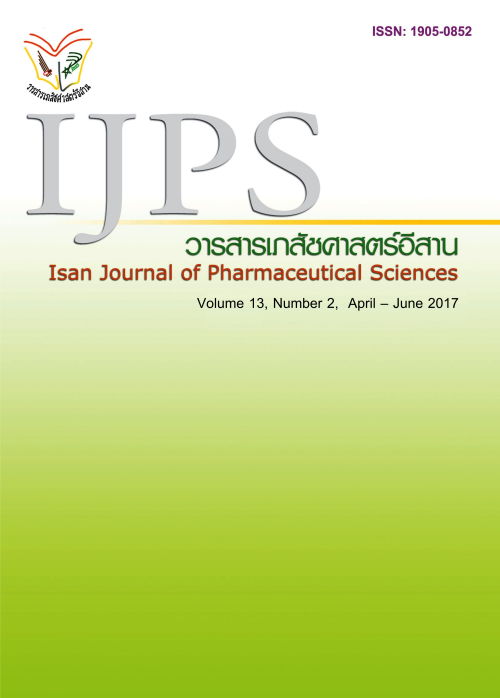The Development of E-Learning in Calculating of Pharmaceutical Concentration and Preparing a Desired Strength of Solution
Main Article Content
Abstract
IntroductionS: Basic skill and understanding of pharmaceutical calculation are important principle in many pharmaceutical activities, for example, dispensing and manufacturing process, which affect the outcome of patient treatment. To improve students’ ability in basic calculation of pharmaceutical concentration and preparing a desired strength of solution, this study was conducted and designed as two groups pretest-posttest quasi-experiment. The objectives of this study were to develop Computer Assisted Instruction (CAI) in a topic of calculating of pharmaceutical concentration and preparing a desired strength of solution for 1st year Diploma of Public Health (Pharmacy Technique) students (n=32) at Sirindhorn College of Public Health Khon Kaen. Methods: Students were randomly allocated to 2 groups. The control group (n=16) recieved handouts and studied by lecturer. The intervention group (n=16) received handouts and CAI to studied by themselves. The outcomes were pretest, posttest and 2 weeks after posttest scores, comments and satisfaction of both groups. Results: the mean score of pretest, posttest and 2 weeks after posttest between 2 groups were not statistical different (p = 0.75, p = 0.55 and p = 0.47 respectively). Posttest score of both groups were significantly higher than pretest score (p < 0.05) same as 2 week posttest score of both groups were significantly higher than posttest score (p < 0.05). The opinion scores of pattern of learning was in a good to excellent level and overall satisfaction score of pattern of learning in control group were significantly higher than intervention group but not statistical difference (p = 0.49). On the other hand, intervention group were significantly higher score in interested CAI than traditional lecture (p < 0.05) However, Intervention group has satisfaction to CAI score was in excellent. In addition, the top 5 issues were 1) the content has sequencing and organization 2) the font size is easy to read, contrast and balance 3) images were consistent with the content 4) audio and graphic are lound and clear 5) the software is easy to use. Conclusion: Studying with CAI improves understanding in calculating of pharmaceutical concentration and preparing a desired strength of solution as same as traditional lecture. CAI lesson could be an alternative teaching method for student to improve the learning effectiveness and promoting of their self-study process.
Keywords: E-Learning, Calculate, Pharmaceutical concentration
Article Details
In the case that some parts are used by others The author must Confirm that obtaining permission to use some of the original authors. And must attach evidence That the permission has been included
References
Arunmanakul P, Permsuwan U. Development and Evaluation of Computer Assisted Instruction for Basic Knowledge about Infectious Diseases. IJPS 2014;10:56-68.
Chanakit T, Kunwaradisai N, Singkhan P, Hemkul S, Teerawatanapong N, Shinghamart N, et al. Computer-aided learning for medical chart review instructions. Afr J Pharm Pharmacol 2012;6(27):2061-7.
Chatchaisucha S, Jitramontree N, Vanicharoenchai V. The Effect of an Intravenous Infusion E-material on the
Second Year Nursing Students’ Ability to Demonstrate the Procedure of Intravenous Infusion. J Nurs Sci 2011;29(Suppl2):143-50.
Chisholm MA. An Internet-based program to teach osteoporosis. Am J Pharm Educ 2002;66:416-20.
Kausar T, Choudhry BN, Gujjar AA. A comparative study to evaluate the effectiveness of computer assisted instruction (CAI) versus class room lecture (CRL) for computer science at ICS level. Turk J Educ Technol 2008;7(4):19-28.
Kunwaradisai N, Chanakit T, Saentaweesook N, et al. Evaluation of Computer Assisted Instruction in Basic Knowledge and Pharmacotherapy for Smoking Cessation. IJPS 2010;6:18-29.
Laohajaratsang T. Computer-assisted instruction. 2nd ed. Bangkok: wongkamol production; 1998.
Mahidol Wittayanusorn School (Public Organization). National Education Act of B.E. 2542 [Online]; 2008 [cited 2015 Sep 11]. Available from: https://www.mwit.ac.th/~person/01-Statutes/NationalEducation.pdf
Ministry of Education. National Education Act of B.E. 2542 [Online]; 1999 [cited 2015 Sep 11]. Available from: http://www.moe.go.th/main2/plan/p-r-b42-01.htm
Pannaroaj P, Paktipat P, Phimarn W, et al. Development and Evaluation of a Computer-Assisted Instructional Program of Antidiabetic Pharmacology. J Sci Technol MSU 2013:442-50.
Payngulume K, Tengkiattrakul S. The Effect of Using Multimedia on Expectation and Satisfaction with the Teaching-Learning Approach in Operating Rooms among Nursing Students. Rama Nurs J 2009;15(3):417-30.
Phimarn W, Anakeveagn A, Sato VH, et al. The Evaluation and Development of Computer-Assisted Instruction Program in Pharmacology of Asthma. Thai Pharm Health Sci 2012;7:16-21.
Phimarn W, Pimdee A, Cushnie B. The Evaluation and Development of Computer-Assisted Instruction Program in Pharmacology: Atiepileptic drug. IJPS 2013;9:50-9.
Pongwichai S. Statistical analysis by computer. 21st ed. Bangkok: Chulalongkorn University; 2010.
Reinhold J, Pontiggia L, Angeles M, Earl G. Instructional design and assessment web-based instruction on substance abuse and drug diversion. Am J Pharm Educ 2010;74(4):1-6.
Rosenberg H, Grad HA, Matear DW. The effectiveness of computer-aided, self-instructional programs in dental education: a systematic review of the literature. J Dent Educ 2003;67(5):524-32.
Srisa-ard B. Analyzing and interpretation of rating-scale data [Online]. date unknown; [cited 2015 Nov 20]. Available from: https://www.google.co.th/url?sa=t&rct=j&q=&esrc=s&source=web&cd=1&cad=rja&uact=8&ved=0ahUKEwiNipetwrLAhVKj44KHSt4CnMQFggaMAA&url=http%3A%2F%2Fwww.watpon.com%2Fboonchom%2F05.doc&usg=AFQjCNE7xVS_Jby0dYaDUY7a2dx0bzeOpw&bvm=bv.118443451,d.c2E


